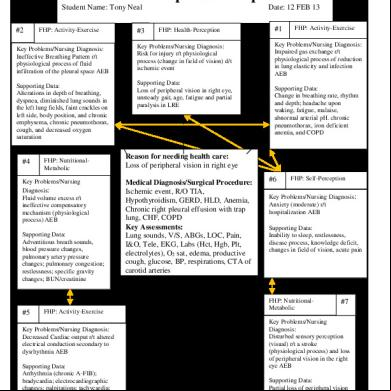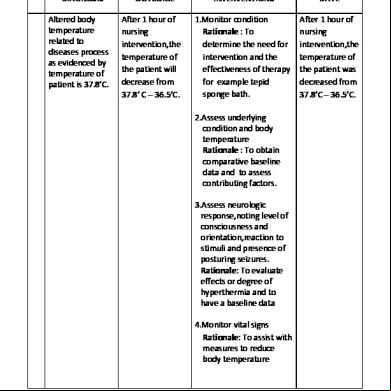Craniotomy Nursing Care Plan 16n5q
This document was ed by and they confirmed that they have the permission to share it. If you are author or own the copyright of this book, please report to us by using this report form. Report 2z6p3t
Overview 5o1f4z
& View Craniotomy Nursing Care Plan as PDF for free.
More details 6z3438
- Words: 729
- Pages: 5
Cues
Nursing Diagnosis Acute pain related to post operative procedure (craniotomy) as evidenced by guarding behavior
Objective:
Goal/ Plan After 1 hour of nursing intervention the patient’s pain will be controlled as evidenced by less guarding behavior, decrease in BP, and less withdraws to pain
Nursing Intervention INDEPENDENT: Determine pain characteristics through client’s gestures and response to interventions
Establishes baseline for assesing improvement/change
Monitor vital signs
High Bp indicates pain; to check patient’s reponding well to interventions
Positioning of client
Avoids direct pressure(intra cranial pressure) to area of post op wound which could result in vasoconstriction/ increased pain.
INTERFERENCE:
Guarding behavior
Behavior response to avoid pain
Restlessness
Expressing behavior for pain
Irritability
Expressing behavior for pain
Change in BP
Elevation of blood pressure promotes vasoconstriction which makes pain increased
Rationale
DEPENDENT: ister specific pain management drugs as prescribed by the physician
Appropriate pain killers to provide relief of discomfort when unrelieved by other measures (e.g. acitaminophen, and anti-inflammatory drugs)
Provide rest periods to facilitate comfort, sleep, and relaxation
The patient’s experiences of pain may become exaggerated as the result of fatigue
COLLABORATIVE: Collaborate with the people from the laboratory
To have a close monitor of the client’s progress regarding its wound and properties biological properties related to her post-op condition
Collaborate with the nuerologist
To update patients prognosis after craniotomy
Evaluation After 1 hour of nursing intervention the patient’s pain is under control as evidenced by less guarding behavior , decreased bp, and less withdraws to pain
Cues
Nursing Diagnosis Ineffective breathing pattern related to neuromuscular dysfunction secondary to Post operative surgery
Planning After 30 minutes of nursing intervention the patient will be able to establish effective respiratory pattern as evidenced by normal respiratory rate, absence of tachypnea
Nursing Intervention INDEPENDENT: Monitor Mechanical ventilator especially the manual RR
To obatain baseline for assesing improvement /change in client’s breathing .
Assess for pain
May limit respiratory effort
Suction airway as needed
To clear out secretions Semi-fowler’s provide good breathing pattern
Objective:
INTERFERENCE:
With oxygen ventilator
The patient needs oxygen to be saturated and assist in breathing
Place head 30 degrees elevated
Tachypnea
The client experiences RR of 3040 Normal is 1:2 ratio
DEPENDENT:
1:1 lung expansion Low hemoglobin
Low concentration of hemoglobin makes poor transport of oxygen
Low potassium
Low potassium weakens muscle strength an neuron function; affects breathing
Pain
Pain makes breathing difficult
Rationale
Adjust oxygen at lowest concentration indicated and prescribed respiratory medications
To suffice needed oxygen requirement of the patient
Give combivent nebule q 6 hrs as prescribed by the phycisian
To provide normal breathing if other measures are ineffective
COLLABORATIVE: Referal to the laboratory
For the CT scan and montioring of patient’s prognosis
evaluation After 30 minutes of nursing intervention the patient established effective
Cues
Diagnosis
Planning
Intervention
Impaired skin integrity related to presence of suture over the head
After 4 days of nursing intervention the patient will display timely wound repair/healing
INDEPENDENT:
INTERFERENCE:
Rationale
Evaluation
Monitor vital signs
To obtain baseline data
After 4 days of nursing intervention the patient displayed timely wound repair/healing
Note changes in color, texture, and turgor
To assess extent of injury
Provide wound care
To assist client in correcting/minimizing condition and to promote optimal healing
Emphasize aseptic technique
A first line defense against nosocomial infections and cross conatmination
Keep the patients position and ensure the suture is intact
To avoid pressure on the wound and to keep it from accidental reopening
Objective: With intact suture on right side of the head
closed site of wound from the post -operation (craniotomy)
Swelling of suture site
Swelling always occurs after surgery and may stay for 5 days; indication risk for infection
DEPENDENT: Hyperthermia
Incision induce elvated temperature
Provide optimum nutrion, increased protien and Vit. C
To aid in healing and for tissue repair
COLLABORATIVE:
The physician knows the time intervals, right frequency of tending the surgical wound and remving of suture.
Assist physician to wound care regimens
Cues
Nursing Diagnosis Risk for infection related to increased WBC count secondary to post-op surgery
Objective data:
INTERFERENCE:
Post-op surgery
Invasive procedure increases risk for invading pathogenic organisms
Inadequate secondary defense
Decreased hemoglobin count
Goal/ Plan
Nursing Intervention
After INDEPENDENT:
DEPENDENT:
COLLABORATIVE: WBC count slightly increased
Swelling of incision site
Signs of potential infection proliferation
Rationale
Evaluation
Cues
Nursing Diagnosis
Subjective Data:
Goal/ Plan
Nursing Intervention
Afte INTERFERENCE:
INDEPENDENT:
Objective data:
DEPENDENT:
COLLABORATIVE:
Rationale
Evaluation
Nursing Diagnosis Acute pain related to post operative procedure (craniotomy) as evidenced by guarding behavior
Objective:
Goal/ Plan After 1 hour of nursing intervention the patient’s pain will be controlled as evidenced by less guarding behavior, decrease in BP, and less withdraws to pain
Nursing Intervention INDEPENDENT: Determine pain characteristics through client’s gestures and response to interventions
Establishes baseline for assesing improvement/change
Monitor vital signs
High Bp indicates pain; to check patient’s reponding well to interventions
Positioning of client
Avoids direct pressure(intra cranial pressure) to area of post op wound which could result in vasoconstriction/ increased pain.
INTERFERENCE:
Guarding behavior
Behavior response to avoid pain
Restlessness
Expressing behavior for pain
Irritability
Expressing behavior for pain
Change in BP
Elevation of blood pressure promotes vasoconstriction which makes pain increased
Rationale
DEPENDENT: ister specific pain management drugs as prescribed by the physician
Appropriate pain killers to provide relief of discomfort when unrelieved by other measures (e.g. acitaminophen, and anti-inflammatory drugs)
Provide rest periods to facilitate comfort, sleep, and relaxation
The patient’s experiences of pain may become exaggerated as the result of fatigue
COLLABORATIVE: Collaborate with the people from the laboratory
To have a close monitor of the client’s progress regarding its wound and properties biological properties related to her post-op condition
Collaborate with the nuerologist
To update patients prognosis after craniotomy
Evaluation After 1 hour of nursing intervention the patient’s pain is under control as evidenced by less guarding behavior , decreased bp, and less withdraws to pain
Cues
Nursing Diagnosis Ineffective breathing pattern related to neuromuscular dysfunction secondary to Post operative surgery
Planning After 30 minutes of nursing intervention the patient will be able to establish effective respiratory pattern as evidenced by normal respiratory rate, absence of tachypnea
Nursing Intervention INDEPENDENT: Monitor Mechanical ventilator especially the manual RR
To obatain baseline for assesing improvement /change in client’s breathing .
Assess for pain
May limit respiratory effort
Suction airway as needed
To clear out secretions Semi-fowler’s provide good breathing pattern
Objective:
INTERFERENCE:
With oxygen ventilator
The patient needs oxygen to be saturated and assist in breathing
Place head 30 degrees elevated
Tachypnea
The client experiences RR of 3040 Normal is 1:2 ratio
DEPENDENT:
1:1 lung expansion Low hemoglobin
Low concentration of hemoglobin makes poor transport of oxygen
Low potassium
Low potassium weakens muscle strength an neuron function; affects breathing
Pain
Pain makes breathing difficult
Rationale
Adjust oxygen at lowest concentration indicated and prescribed respiratory medications
To suffice needed oxygen requirement of the patient
Give combivent nebule q 6 hrs as prescribed by the phycisian
To provide normal breathing if other measures are ineffective
COLLABORATIVE: Referal to the laboratory
For the CT scan and montioring of patient’s prognosis
evaluation After 30 minutes of nursing intervention the patient established effective
Cues
Diagnosis
Planning
Intervention
Impaired skin integrity related to presence of suture over the head
After 4 days of nursing intervention the patient will display timely wound repair/healing
INDEPENDENT:
INTERFERENCE:
Rationale
Evaluation
Monitor vital signs
To obtain baseline data
After 4 days of nursing intervention the patient displayed timely wound repair/healing
Note changes in color, texture, and turgor
To assess extent of injury
Provide wound care
To assist client in correcting/minimizing condition and to promote optimal healing
Emphasize aseptic technique
A first line defense against nosocomial infections and cross conatmination
Keep the patients position and ensure the suture is intact
To avoid pressure on the wound and to keep it from accidental reopening
Objective: With intact suture on right side of the head
closed site of wound from the post -operation (craniotomy)
Swelling of suture site
Swelling always occurs after surgery and may stay for 5 days; indication risk for infection
DEPENDENT: Hyperthermia
Incision induce elvated temperature
Provide optimum nutrion, increased protien and Vit. C
To aid in healing and for tissue repair
COLLABORATIVE:
The physician knows the time intervals, right frequency of tending the surgical wound and remving of suture.
Assist physician to wound care regimens
Cues
Nursing Diagnosis Risk for infection related to increased WBC count secondary to post-op surgery
Objective data:
INTERFERENCE:
Post-op surgery
Invasive procedure increases risk for invading pathogenic organisms
Inadequate secondary defense
Decreased hemoglobin count
Goal/ Plan
Nursing Intervention
After INDEPENDENT:
DEPENDENT:
COLLABORATIVE: WBC count slightly increased
Swelling of incision site
Signs of potential infection proliferation
Rationale
Evaluation
Cues
Nursing Diagnosis
Subjective Data:
Goal/ Plan
Nursing Intervention
Afte INTERFERENCE:
INDEPENDENT:
Objective data:
DEPENDENT:
COLLABORATIVE:
Rationale
Evaluation










